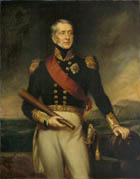Colonial Wars |
American Wars |
Rear Admiral Sir George Cockburn
Sir George Cockburn was born 22 April 1772 in London, England and died on 19 August 1853 in Leamington Spa, Warwickshire, England. He was a British navy Officer during the War of 1812
 |
| NAME |
| Cockburn, George |
| BORN |
| 22 April 1772 London, England |
| DIED |
| 19 August 1853 Leamington Spa, Warwickshire, England |
| NAVY |
| British |
As the second son of Sir James Cockburn, George was slated for a career at sea at the age of 9 years old. After serving aboard a number of vessels in the British Isles, the Mediterranean Sea, and other stations, he reached the rank of lieutenant at the age of 21 years old. Srening in Lord Hood's squadron during the French wars of the 1790's, he gained command of his own sloop, the HMS Speedy. Moving up to the frigate HMS Meleager in 1794, he was involved in the battles off Toulon in 1795. Shortly thereafter, he served under and became a friend of Lord Nelson. As commander of the frigate HMS Minerve, he served the remainder of the war in the Mediterranean, preying primarily on privateers and capturing many prizes.
As war loomed in 1803, Cockburn commanded the HMS Phaeton in the East Indies. He moved to the West Indies in 1808 as commander of HMS Pompee and aided in the capture of Martinique. Until 1812, he served off the coast of Spain, aiding the forces of the disposed king of Spain and rising to the rank of rear admiral. In August, after word reached Europe of the U.S. declaration of war, he was sent to North American waters to serve under the command of Sir John B. Warren. Warren immediately directed Cockburn to Chesapeake Bay to destroy American supplies in that region. After he arrived at Chesapeake Bay aboard the HMS Marlborough and bringing numerous support craft, he immediately began a series of raids on coastal towns. After sending part of his force to harass other areas, such as Delaware Bay, he moved up the Chesapeake; after threatening Baltimore, he moved to the Elk River.
Though he always claimed that he would respect private property unless local citizens resisted his force, in the upper bay, Cockburn took little pains to distinguish between private and public property. Under his command, the British Navy seized Frenchtown, Havre de Grace, Georgetown, and Fredericktown, They confiscated the merchandise in the warehouses and stores before burning them. Following a similar attack on Hampton, Virginia, he was accused by some American journalists of turning a blind eye while some of his sailors looted private property and even committed rape.
In August 1814, Cockburn cornered Commodore Joshua Barney's fleet of gunboats up the Patuxent River with the intention of destroying them, a task Barney spared him by blowing up his own boats. Cockburn then accompanied Maj. Gen. Robert Ross on the overland march on Washington, D.C . While overall commander of the expedition, Cochrane recalled Ross's force and convinced Ross to go on since there had been no appreciable American resistance this far.
During the subsequent burning of Washington, D.C., Cockburn personally oversaw the destruction of the virulently anti-British newspaper, the National Intelligencer's offices. "Make sure that all the C's are destroyed," Cockburn reputedly told the soldiers, "so that the rascals can have no further means of abusing my name." Following the British failure to take Baltimore, Cockburn continued raiding in the Chesapeake area until the end of the war.
After the famous British victory at Waterloo, Cockburn was charged with the command of the ship that took Napoleon to exile on St. Helena. He remained as the governor of that island until 1816. Cockburn became admiral of the fleet in 1851.
In 1839 he became the first President of the Shipwrecked Fishermen and Mariners' Royal Benevolent Society. In 1852, he inherited the family baronetcy from his elder brother, being himself succeeded by his brother William, dean of York, who died in 1858. Admiral Cockburn died in 1853 at Leamington Spa, leaving a daughter.
